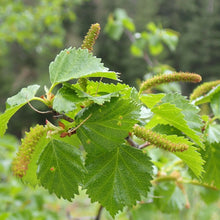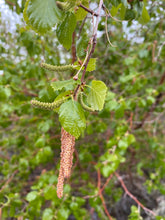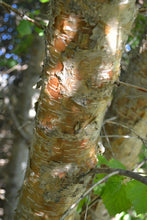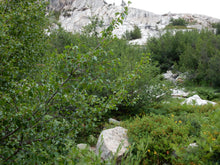
Betula occidentalis
Water birch is a multi-trunked small tree that is an alluring addition to moist woodland gardens - especially those with natural or human-made water features like streams or ponds. In spring, it sports delicate catkins that dangle from its slender branches. The bark of its young twigs is characterized by resin-filled blisters that ooze sap and attract sapsuckers and hummingbirds and the bright green, sharp-toothed leaves are an important source of food for native butterfly and moth larvae. In autumn, the leaves turn bright yellow and provide great fall color before cascading to the ground, exposing its copper-rust colored bark in winter.
- Plant type/canopy layer: deciduous, perennial, medium-sized tree
- Size at maturity: 20-50' tall, 10-40' wide canopy
- Light requirements: full shade, part sun/part shade
- Moisture requirements: moist to wet soil
- Bloom time: April - July
- Growth rate/ease: medium to fast growing, easy to grow
- Wildlife support: flowers attract and provide nectar to hummingbirds, and adult butterflies; overall plant is a caterpillar host plant and larval food source for native moths and butterflies including the tiger Swallowtail butterfly, Ceanothus Silkmoth (Hyalophora euryalus) and Morning Cloak (Nymphalis antiopa)
- Native habitat/range: found along streams, riverbanks and springs at medium to high elevations, generally east of the Cascade pass across the Pacific Northwest to southern California - but performs well as a yard tree in the Portland metro area. Portland Plant List - No.
- Special features & uses: great fall color; hummingbird and butterfly attractor; landscape uses include erosion control, bank stabilization, pollinator and butterfly gardens, woodland gardens and habitat hedgerows
Gardening with Water Birch: This tree is an excellent habitat plant and worthwhile addition to moist woodland gardens. It does not spread vigorously and is generally care-free if planted in the right place. It prefers part to full shade and moist to wet soils. It’s not fussy about soil drainage and has a high tolerance for flooding, with roots that help prevent soil erosion and stabilize banks. If planted in drier soils, it may need occasional deep waterings (i.e. 2-3 x per month) during the summer drought. If a particular shape is desired, prune in late fall as soon as leaves have dropped.
Photo Credit 1: "Betula occidentalis" by mfeaver is licensed under CC BY 4.0.
Photo Credit 2: "Betula occidentalis" by Matt Berger is licensed under CC BY 4.0.
Photo Credit 3: "Betula occidentalis (western birch) in Weed, Ca." by theforestprimeval is licensed under CC BY-SA 2.0.
Photo Credit 4: "Betula occidentalis" by John Gaskin is marked with CC0 1.0.
Photo Credit 5: "Betula occidentalis" by Matt Lavin is licensed under CC BY-SA 4.0.









